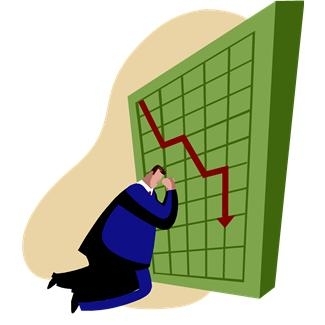| Home | About | Archives | RSS Feed |

@theMarket: Where Is the Bottom?
 Everyone seems to be looking for the same thing, an end to the pain, an end to the stress, a place where the selling stops. It's called a bottom and it appears to me that we haven't found one yet.
Everyone seems to be looking for the same thing, an end to the pain, an end to the stress, a place where the selling stops. It's called a bottom and it appears to me that we haven't found one yet.
One contrary indicator is the sheer number of bottom fishers who are trying to outguess each other on how low the markets can go. Normally bottoms are reached when no one wants to buy and everyone believes the markets are never, ever coming back. So far, I have seen no evidence that investors are in that state of mind.
This has been a waterfall decline and as such, one can look back through history and see how markets have reacted to past selloffs of this type. If you haven't read my Aug. 11 column, "What To Expect From After a Waterfall Decline" please be sure to read it.
Over the last two weeks, the market declined to about 1,100 on the S&P 500 Index and then proceeded to bounce 9.5 percent to about 1,204. Many think that was the bottom. But was it? I looked at some historical data on past waterfall declines, compliments of Ned Davis Research, a highly respected financial firm, hoping to confirm or deny that supposition.
I found that in 8 of 11 post-waterfall decline cases since 1929, the market has made lower lows. So far this decline has been a textbook waterfall decline. They all begin with a breath-taking whoosh downward, find an interim bottom, (in this case S&P 1,100) and proceed to bounce about 10 percent to an interim peak. Our rally this week to 1,204 was about 9.5 percent and would certainly seem to qualify as an interim peak.
Eventually this interim peak is followed by a decline to the final bottom, which in past declines have averaged about 14 percent to 16 percent. That would put the S&P 500 Index at around 1,020. But that is an average decline. If you look at waterfall declines that were caused by debt-related fears such as in 2008, 1940, 1937, 1938 and 1929, then, the bottoms were a good 10-15 percent lower than the average.
Now that does not mean that this decline must replicate past performances. And remember, too, that this type of bottom occurred in 73 percent of the cases since 1929. Therefore, 2011 could turn out differently. My intention is neither to frighten readers nor to call the bottom but rather to give you an idea of what has happened in the past and give you a framework for future risk/reward. At the very least, I would think that there is sufficient historical data to reframe from jumping into the market again at some arbitrary number whether it be 1,100, 1,075 or 1,020.
Bottoms are rarely V-shaped. There is usually a basing period of several months where the markets trade up and down, testing the lows until a sufficient amount of evidence convinces investors to get back in the market. The sectors that perform the best in a basing/testing period are health care, energy, consumer staples, telecom and utilities. Once the market bottom is in, then the sectors with higher betas such as technology, consumer discretionary, financials and industrials outperform.
Bill Schmick is an independent investor with Berkshire Money Management. (See "About" for more information.) None of the information presented in any of these articles is intended to be and should not be construed as an endorsement of BMM or a solicitation to become a client of BMM. The reader should not assume that any strategies, or specific investments discussed are employed, bought, sold or held by BMM. Direct your inquiries to Bill at (toll free) or e-mail him at wschmick@fairpoint.net . Visit www.afewdollarsmore.com for more of Bill's insights.
| Tags: decline, waterfall, bottom, history |
Independent Investor: Europe's Banking Crisis
 Investors are selling first and waiting for the facts later. Few can blame them given their experience in 2008-2009. Investors in the stock market sustained huge losses by naively believing that the financial sector and the government were in control of that crisis. This time around, no one believes anything they say.
Investors are selling first and waiting for the facts later. Few can blame them given their experience in 2008-2009. Investors in the stock market sustained huge losses by naively believing that the financial sector and the government were in control of that crisis. This time around, no one believes anything they say.
The problem is compounded by the fact that this financial crisis is located in Europe where different rules apply, where the political and financial systems are different and where even the time zones play a part. Wednesday's panicked selloff was largely a result of a front-page story in the Wall Street Journal that revealed that the Federal Reserve Bank is scrutinizing the U.S. subsidiaries of all the European banks.
The Fed is worried that Europe's banks, faced with a dwindling supply of cash to pay off loans and remain solvent, are emptying the cash coffers of their U.S. operations. The latest Fed data, according to the WSJ, indicated that over the last three weeks, the cash reserves of these American subsidiaries have declined by 16 percent.
There was also a mention that one European bank borrowed $500 million in a one week loan from the European Central Bank at a higher interest rate than could be borrowed from fellow lenders at a cheaper rate. Investors sold first, assuming that, in at least this one case, some European bank was in deep financial trouble and where there is smoke there is usually fire. The facts do not support that conclusion — at this time. European banks still have massive reserves here, as much as $600 billion or more.
"At this time" is key because Friday the facts could change and during our financial crisis the facts did change, to our detriment, quite often. Because of our recent past, investors have no faith in either government's or the banking community's ability to solve our economic or financial problems. We have even less faith (if that's possible) in the European Union. Some of that disbelief is warranted. After all, the EU is an economic, not a political union. Given that there has never been a successful union that did not incorporate both politics and economy, the Achilles Heal of Europe is now surfacing.
This week the Europeans tried several initiatives that disappointed investors. First, several European nations announced new rules to prevent short selling of their banking stocks. The U.S. did the same thing during our financial crisis which proved to be both short-lived and completely ineffective. Within three days those same banking stocks were down 10 percent or more as investors simply found new ways to sell those stocks.
A meeting between Germany and France on Tuesday had the markets hoping that the two power houses of Europe would announce new, sweeping initiatives that might finally come to grips with the spreading European crisis. Instead, Chancellor Angela Merkel and French President Nicolas Sarkozy proposed that Euro-zone leaders should meet more often and recommended appointing a new Euro-zone chief, but didn't say what kind of power they would have in dictating EU policy. Big deal!
Remember the $157 billion Greek bailout that was supposed to be signed, sealed and delivered? Well, not quite; it appears several nations want cash-strapped Greece to provide cash as collateral in exchange for their participation in the bailout loan. It seems a growing swell of anti-bailout sentiment is rising in an increasing number of countries.
Coupled with these disappointing developments, Germany's most recent GDP second-quarter data indicated annualized growth has slowed to 0.05 percent. That punctured any hope that Germany, whose economy was considered the locomotive of Europe, would continue to support overall growth of the 17 Euro nations. Add a banking crisis, coupled with a deep distrust of existing authority, the increasing fear of a double-dip recession and the lack of political unity equals a continued wave of panic selling.
What could turn this around? A once and for all comprehensive plan by Europe to solve their burgeoning debt crisis might be the answer. But can that be done without addressing the "Elephant in the Room," i.e., political unity? Probably not, if a politically-divided U.S. Congress can't come to an agreement on our economic issues, how hard will it be for the EU to do the same?
Bill Schmick is an independent investor with Berkshire Money Management. (See "About" for more information.) None of the information presented in any of these articles is intended to be and should not be construed as an endorsement of BMM or a solicitation to become a client of BMM. The reader should not assume that any strategies, or specific investments discussed are employed, bought, sold or held by BMM. Direct your inquiries to Bill at (toll free) or e-mail him at wschmick@fairpoint.net . Visit www.afewdollarsmore.com for more of Bill's insights.
| Tags: Greece, bailout, Europe, banking crisis |
@theMarket: The Name of the Game — Dividends & Interest
 Last week, I advised investors to "wait for the bounce" before getting more defensive. We've had three bounces this week, so by now you are either out of your most aggressive investments or nearly so. Stay defensive.
Last week, I advised investors to "wait for the bounce" before getting more defensive. We've had three bounces this week, so by now you are either out of your most aggressive investments or nearly so. Stay defensive.
Never has the Dow Jones Industrial Average experienced the kind of swings we have witnessed this week. With 400-500 point swings a day, up and down, it is clear to me that high frequency trading owns the stock market right now. It is no place for the individual investor.
"Have we put in a low?" asks a client from Northern Berkshire County.
It seems so, but only time will tell. I know that is a iffy answer but here's why: The S&P 500 Index has bounced off 1,100 twice this week, giving technical analysts some hope that we have found a level where buyers are willing to step in. Since then, we have climbed almost 100 points or 6 percent in just two days. Normally, the next reaction will be a retest of the lows. That will determine whether 1,100 truly is the low. If it breaks — look out below. We could easily drop another 50-100 points.
Now you will probably agree that for most of us, that isn't a bet we are willing to make, especially if your portfolio is still fairly aggressive. That's why I am suggesting that you take a more defensive stance. Switch to large cap dividend socks, corporate bonds and, if you have the risk appetite, high-yield bonds as well. There are dozens of exchange-traded and mutual funds that offer plenty of choices; just watch out for high expense ratios and front load sales charges.
"Why not go to cash?"
That is a question I've heard repeatedly this week from clients throughout the Northeast.
In general, I wouldn't forsake the stock market quite yet. The jury is still out on whether we are heading for a recession. If we continue to wallow along in our slow growth, low interest rate, high unemployment economy, then the stock market is not going to decline much further. On the other hand, it won't be going up much either.
In that kind of environment, you want to find the highest dividend and interest income bearing investments around. Think of it this way: if the stock market provides sub-par returns for the next year or two (1-2-3 percent) than capturing interest and income returns of 3-6 percent will be a great way of beating the market and reducing your risk.
Fortunately, thanks to the market selloff, you can pick up great deals in that area right now. Those large cap companies that have a large part of their business overseas and pay large dividends are ideal candidates. But don't forget preferred stocks, they are a great way of both participating in any upside in the market while enjoying a healthy stream of income.
The risk of a spike in interest rates has receded. Now that the Federal Reserve Bank has assured investors this week that they will keep interest rates low until the middle of 2013. Investors have been given a window of opportunity to hunt for higher yielding alternatives to U.S. Treasury bonds. So over on the bond side, corporate bonds — both investment grade and high yield — make sense.
The wild card in this strategy is that the Obama administration or the Fed surprises us with another program to stimulate the economy. After all, there are some uncanny similarities between what is happening right now and what happened during this same time period last year. The stock market has declined by about the same amount. Investors were greatly concerned last August (as they are now) that the economy was slipping back into recession.
In late August of last year, Fed Chairman Ben Bernanke announced QE II at the Fed's annual meeting in Jackson Hole, Wyo. Bernanke will speak again on Aug. 26 at the same meeting. Some hope he will announce a second market-propping program to further stimulate the economy, something we now know the central bank is at least discussing. That belief stems from the following sentence buried in this week's FOMC statement
"The Committee discussed the range of policy tools available to promote a stronger economic recovery in a context of price stability."
That statement, although short, was significant, but was largely overlooked as the news of the Fed's decision to extend its low-interest-rates policy to 2013 took precedence among the nation's media. Now, just because the open market committee is discussing these things doesn't mean they are ready to act. Nonetheless, it is a possibility. Be forewarned that the volatility in the markets will continue as more participants move to the sidelines, leaving only high-frequency traders and their computers to battle it out minute by minute.
Bill Schmick is an independent investor with Berkshire Money Management. (See "About" for more information.) None of the information presented in any of these articles is intended to be and should not be construed as an endorsement of BMM or a solicitation to become a client of BMM. The reader should not assume that any strategies, or specific investments discussed are employed, bought, sold or held by BMM. Direct your inquiries to Bill at (toll free) or e-mail him at wschmick@fairpoint.net . Visit www.afewdollarsmore.com for more of Bill's insights.
Independent Investor: What To Expect After a Waterfall Decline
 It's been one heck of a two weeks. One would think the world was coming to an end, given the way global markets have behaved. You may not be able to make much sense of why markets sold off so quickly, but out of the carnage we may be able to predict what comes next. Here's why.
It's been one heck of a two weeks. One would think the world was coming to an end, given the way global markets have behaved. You may not be able to make much sense of why markets sold off so quickly, but out of the carnage we may be able to predict what comes next. Here's why.
Stock market free falls, such as the one we are presently experiencing, are called "waterfall declines," which are sudden drops of 20 percent or more compressed into a few short weeks or days. They are fairly rare events and most follow a roughly similar pattern consisting of three phases.
The first phase is the decline itself followed by a sharp bounce higher. We may be experiencing that bounce right now. Following the bounce (and possible re-test of the lows), the market should drift into a basing period that could last for one to three months.
During that time the market could move up and down in a sideways pattern similar to what we experienced in May through June of this year. Finally in the last phase there is a rally lasting six to 12 months that could move the markets higher by about 25 percent.
In reviewing 10 waterfall declines from 1929 thorough 2002, three months after the post-waterfall low, the stock market was higher in all 10 cases. Six months later, the market was higher in nine of the 10 cases with the average gain at 17 percent. A year later, the market was higher in nine out of 10 cases with the average gain equal to 24 percent. The financial crisis of 2008-2009 was in a league all by itself. The market, three months after the low of March 2009, was up 37 percent.
If we drill down even further, say to the next two weeks, one can expect a "relief rally" of as much as 10 percent. Then, if the pattern holds, we should "re-test" the bottom. In this case, if we have truly found a bottom for the S&P 500 Index at around 1,100, we should bounce again from there.
"So what happens if we break down through that 1,100 level?" asked a nervous client from Manhattan.
The short answer is 1,100 wasn't the bottom and we go lower, by as much as 10 percent, to S&P 1,000.
Waterfall declines are often recession-related. There have been exceptions to that rule, for example, in 1987 the market fell sharply for two days only to spring back. The Dot-Com boom and bust of 2002 was another waterfall decline that did not usher in a recession.
So what is the best way to navigate through a waterfall decline and its aftermath? It is obvious that one should ride out the turbulence; at least for the next few months. If we are truly entering into a recession, the economic data will confirm that fear or dispel it. If we are going into a double-dip, then I advise you to get defensive—bonds, dividend paying stocks, etc.
But it may turn out that the market was simply correcting, as it does periodically after a long and profitable run. Remember, the S&P 500 Index was up over 80 percent in over two years, so a 20 percent pullback doesn't look as serious from that perspective.
Bill Schmick is an independent investor with Berkshire Money Management. (See "About" for more information.) None of the information presented in any of these articles is intended to be and should not be construed as an endorsement of BMM or a solicitation to become a client of BMM. The reader should not assume that any strategies, or specific investments discussed are employed, bought, sold or held by BMM. Direct your inquiries to Bill at (toll free) or e-mail him at wschmick@fairpoint.net . Visit www.afewdollarsmore.com for more of Bill's insights.
| Tags: waterfall, bounce, stocks |
@theMarket: Now What?
 Unless you have been living in a vacuum, you are keenly aware of the stock market's freefall. Panic is in the air and rumors are swirling around the Street's trading floors. It is time for investors to step back and take a breath.
Unless you have been living in a vacuum, you are keenly aware of the stock market's freefall. Panic is in the air and rumors are swirling around the Street's trading floors. It is time for investors to step back and take a breath.
If you are worrying about your retirement accounts, don't. This is not 2008-2009. Much of what is going on in the markets is a result of conjecture, not facts. No one knows if we are going into another recession. No one knows if Italy is going to go bankrupt, no one knows the future. At most, we can only make educated guesses.
Let me first admit that I was definitely wrong last week when I posed the question "Buy or Sell" in my column. I advised readers to hold onto their investments. Like many others, I was expecting a rally in stocks after the successful passage of a debt-limit increase. Even though I expressed my deep concerns over the weakening of the economy, I was caught like everyone else going the wrong way when the markets dropped through the floor. That said, I believe it is too late to sell and, if I do, I will wait first for a bounce.
Selling a market already down 12 percent in 10 out of 11 days is not a smart move. We are close to, if not already in, that zone of capitulation where panic takes over and investors want out at any price. Thursday was over a 95/5 day during which 95 stocks were sold for every five purchased. The New York Stock Exchange Index is so oversold that it registers a minus-2 standard deviation (SD). These are all signs of a near-term bottom.
My friend John Roque, technical strategist over at WJP Capital Group, indicates that when stocks are this oversold, a relief rally is not far behind. In 100 percent of the cases over the last 30 years where a minus-2 SD occurred, the markets have bounced anywhere from 2 percent to over 10 percent within two weeks. Three months later, the same markets gained 3.6 percent to 34 percent. So the odds are in your favor that selling now would be a losing proposition.
"OK, I wait for a bounce," says a client from Becket, "then what?"
That depends. Many times after a relief rally (sometimes called a dead cat bounce) the markets return to, at, or near the lows before moving higher. At other times, there is a week or two of pause before markets resume an upward climb. Last year, the S&P 500 Index lost almost 18 percent and then rallied straight up with no retest. It could happen again but we will need to get the bounce first before guessing at its durability.
The reason this correction feels so different from last year's is the compressed nature of the decline. What took four months to accomplish in 2010 has taken only 11 days thus far this year. In some ways, a short sharp correction is better than a drawn out death by a thousand cuts kind of correction, although both are painful.
So here's my game plan: stay invested, wait for the bounce, when it occurs sell some of your most aggressive investments and see what happens. If we retrace, buy at or close to the bottom. If we continue to climb, the worst that can happen is you miss a few percentage points of gains. But remember, preserving principle is your No. 1 concern. Profits should come second.
Bill Schmick is an independent investor with Berkshire Money Management. (See "About" for more information.) None of the information presented in any of these articles is intended to be and should not be construed as an endorsement of BMM or a solicitation to become a client of BMM. The reader should not assume that any strategies, or specific investments discussed are employed, bought, sold or held by BMM. Direct your inquiries to Bill at (toll free) or e-mail him at wschmick@fairpoint.net . Visit www.afewdollarsmore.com for more of Bill's insights.
| Tags: crash, bottom, dead cat bounce |

